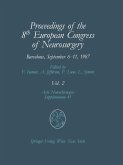To complement the general overview and offer readers a more 'hands-on' sense of context and atmosphere, extensive historical references, stories, media news and illustrative cases have been included for each historical and geographical scenario. In addition, original illustrations and plates of these archaic instruments and techniques are supplied.
Neurosurgical surgeons, nurses, technicians, medical historiographers, paleo-pathologists and researchers interested in surgical techniques for cranial opening will find the volume a valuable guide, intended to increase the historical and cultural awareness of this core topic in neurological surgery.
Dieser Download kann aus rechtlichen Gründen nur mit Rechnungsadresse in A, B, BG, CY, CZ, D, DK, EW, E, FIN, F, GR, HR, H, IRL, I, LT, L, LR, M, NL, PL, P, R, S, SLO, SK ausgeliefert werden.









